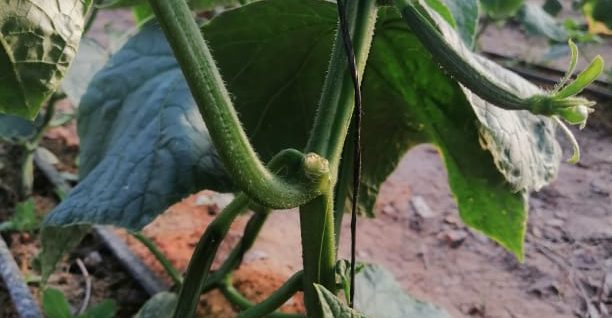As mentioned, Mr. Chatama decided on English cucumbers because they are easy to market. Also, by harvesting three times per year, he can maximize the yield. Mr. Chatama’s greenhouse is 320 m2, and he has planted 500 cucumber plants there.
English cucumbers are sweet, slender, and straight, and have fewer, less noticeable seeds than many other cucumbers. You’ll also see them called greenhouse cucumbers, hot house cucumbers, European cucumbers, and seedless cucumbers.
English cucumbers are about 14 inches long and about 1-1/2 to 2 inches in diameter. They’re grown off the ground, hanging or on a trellis, to get their characteristic shape. They’re also self-pollinating, which allows them to be grown indoors in greenhouses because they don’t need bees, animals, or wind to help them produce seeds and fruit.
At the supermarket, you’ll probably find just one type of English cucumber. At a farm stand or nursery, however, you might find varieties like these: English Sweet Long Slim Hybrid Cucumber, English Long Sweet Crunch Hybrid Cucumber, Heirloom English Long Telegraph Cucumber, Chelsea Prize Hybrid English Cucumber, Sweet Success English Hybrid Cucumber
Cucumbers aren’t the only produce that comes in an English variety. There are English parsnips, watercress, lavender, and thyme, too. And English cucumbers are just one of many cukes with a country- or region-specific name. Here are some other cucumber varieties you may have heard of, especially if you’re a gardener: Japanese cucumber, Armenian cucumber, Persian cucumber, Mediterranean cucumber, Chinese cucumber, Mexican sour cucumber, Brown Russian cucumber, Parisian cucumber.
We have all these types of cucumbers today because people spread them around the world from the fruit origins in India.
Growing English cucumbers is not hard if you know what you are doing, and Mr. Chatama knows what he is doing. Below, you can see Mr. Chatama and his sons, preparing the greenhouse and the plants. They use strings like baling twine tied to wires stretching from one shoulder (like 2 or 3m above the ground) of the greenhouse to the other. This will allow the plant to wind its way up vertically, using the strings for support. Then they remove the first four cucumbers of every plant for the plant to grow stronger and increase the yield. Finally, you can see the cucumber with flowers.



